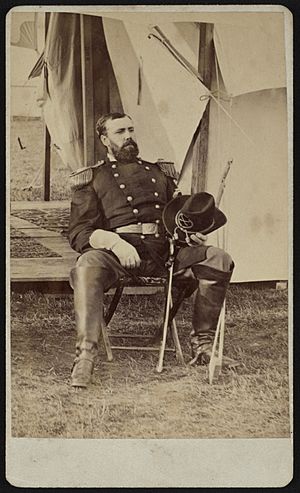Eugene Asa Carr facts for kids
Quick facts for kids
Eugene Asa Carr
|
|
|---|---|
 |
|
| Born | March 20, 1830 Hamburg, New York |
| Died | December 2, 1910 (aged 80) Washington, D.C. |
| Place of burial |
West Point Cemetery
|
| Allegiance | United States of America Union |
| Service/ |
United States Army Union Army |
| Years of service | 1850–1893 |
| Rank | |
| Unit | |
| Commands held | 3rd Regiment Illinois Volunteer Cavalry Army of the Southwest 6th Regiment U.S. Cavalry |
| Battles/wars | Indian Wars
|
| Awards | Medal of Honor |

Eugene Asa Carr (born March 20, 1830, died December 2, 1910) was an important soldier in the United States Army. He became a general in the Union Army during the American Civil War. He even received the Medal of Honor, which is a very special award, for his bravery at the Battle of Pea Ridge.
Contents
Growing Up and Early Military Days
Eugene Asa Carr was born in Hamburg, New York. He went to the United States Military Academy in West Point, New York. He graduated in 1850, ranking 19th in his class of 44 students.
After West Point, he became a second lieutenant. He served in the Indian Wars until 1861. His first fight was on October 3, 1854, against Apaches near the Sierra Diablo Mountains. By 1861, he was a captain in the 1st U.S. Cavalry. He was in charge of Fort Washita in what was then called the Indian Territory.
Eugene Carr in the Civil War
Carr's first big battle in the American Civil War was the Battle of Wilson's Creek on August 10, 1861. Soon after, he became a colonel in the 3rd Illinois Cavalry.
The Battle of Pea Ridge
At the Battle of Pea Ridge in Arkansas on March 7, 1862, Carr led his soldiers in a tough fight. He was hurt three times during the battle: in his neck, arm, and ankle. For his courage and leadership, he was later given the Medal of Honor. The award recognized how he kept his troops fighting even while under heavy fire and being wounded.
On April 30, 1862, President Abraham Lincoln made Carr a brigadier general. This promotion showed how much his bravery was valued.
Fighting in Vicksburg and Beyond
Carr played a key role in the Vicksburg Campaign. He led an attack at the Battle of Port Gibson. He also fought in important battles like Champion's Hill and the Siege of Vicksburg. After Vicksburg was captured, Carr moved to Arkansas.
He later commanded cavalry troops during the Camden Expedition. For the rest of 1864, he was in charge of the District of Little Rock. His last major fight in the war was at the Battle of Fort Blakely in Alabama. In 1865, he was promoted to major general. He left the volunteer army in January 1866.
After the Civil War
After the Civil War, Carr stayed in the Regular Army. He continued to serve on the frontier, leading successful missions against Native American tribes. He won a significant battle at Summit Springs.
In 1879, he became a colonel in the 6th Cavalry Regiment. He was promoted to brigadier general in 1892. He was also involved in the incident at Cibecue Creek with the Apache in 1881. From 1888 to 1890, he was the last commander of the District of New Mexico.
Carr retired from the army in 1893. His military friends called him "The Black-Bearded Cossack." Eugene Asa Carr passed away in Washington, D.C. in 1910. He is buried at the West Point Cemetery in New York.

